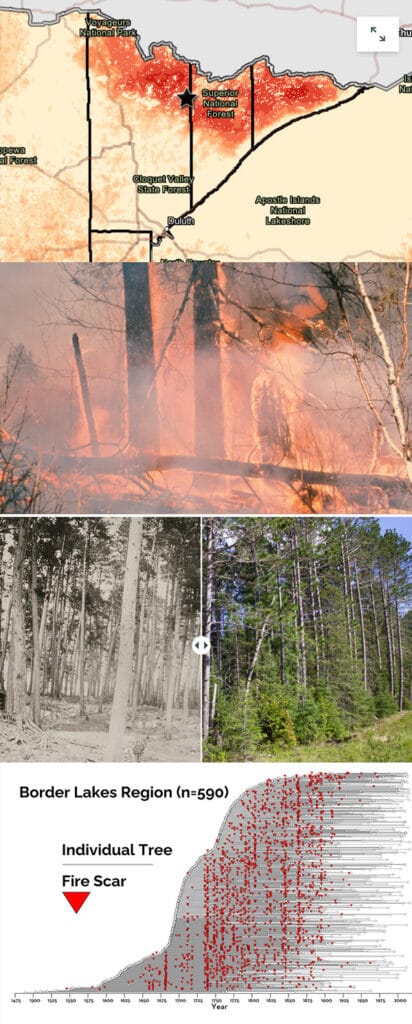A new short film produced by the University of Minnesota and partners including tribal fire specialists, seeks to regenerate respect for the positive impacts of fire on northern Minnesota’s ecosystem. In the same way fire helps the forest stay healthy and rich in diverse plants and animals, the film is part of an effort to help humans return to a closer harmony with the boreal forest they live in.
Titled Oshkigin Spirit of Fire, the video educates viewers about historic fire practices used by Anishinabe people, and celebrates the sense of reciprocity inherent to letting fire do its work for the natural world.
“My hope with the film is that viewers will more fully appreciate the multi-faceted nature of fire in the places we live, play, and rely on for sustenance. Fire has mediated the relationship between people and land for generations,” said forest researcher Lane Johnson of the Cloquet Forestry Center. “We badly need good fire in our prairies, woodlands, and forests to maintain and enhance our region’s fire-adapted biodiversity. Prescribed fire is more than a land management tool, it is part of our caretaking responsibility as inhabitants of Minnesota. Fire restoration is a way to thank the land, and all our non-human relatives, for all they have given us.”
Johnson is one of the researchers who has been using tree ring science in recent years to better understand Indigenous use of fire. Examining tree rings and scars has helped reconstruct hundreds of years of fire history in the Boundary Waters and surrounding area. Research has shown that fires were frequently set in certain areas.
Oshkigin features the perspectives of Damon Panek, a wildland firefighter and cultural expert from the White Earth and Red Cliff Ojibwe Reservations in northern Minnesota and Wisconsin, respectively, and Vern Northrup, a retired firefighter and elder from the Fond du Lac Reservation in Minnesota. Also involved was Melonee Montano of the Red Cliff Band.
Indigenous people long set fires in the region to provide benefits for their communities and the ecosystem. It promoted the growth of bountiful blueberry crops, open forests, and much more. Many plants that depend on ecosystems with regular fire are also medicines used to cure many ailments. Indigenous fire use is informed by generations of careful experimentation and observation.
“This was the scientific method in process,” Panek said. “They were testing hypotheses.”
In the 20th century, especially after the Hinckley Fire of 1894, fire suppression policies were put in place with the prevailing belief that fire was a threat to forests. It forced Native people to stop their cultural practices, and had profound impacts on the ecosystem. In the meantime, lands were often divided up and developed, making fires more risky to people and property.
Suppressing fires for a century has created conditions that are potentially more destructive. Indigenous people generally set small, low-intensity fires to burn away brush and accomplish other goals. But forests where fires have been put out for more than 100 years build up thick understories that can cause big, hot fires.
“As a tree-ring researcher studying fire history, I’ve come to know fire as both an ecological and cultural phenomenon,” Johnson said. “Tree-ring records can tell us where and when fires burned in the past, but Indigenous knowledge helps provide the cultural context needed to better interpret the fire record. I have learned so much through my conversations with Damon, Vern, and Melonee. The film is a durable way to share some of their knowledge and perspective with others.”
The film concludes with a message calling for returning fire to the landscape and seeking knowledge from Indigenous experts. Oshkigin was produced by Dovetail Partners and Old Saw Media, directed by Tom Deschenes and Andrew Bydlon.


